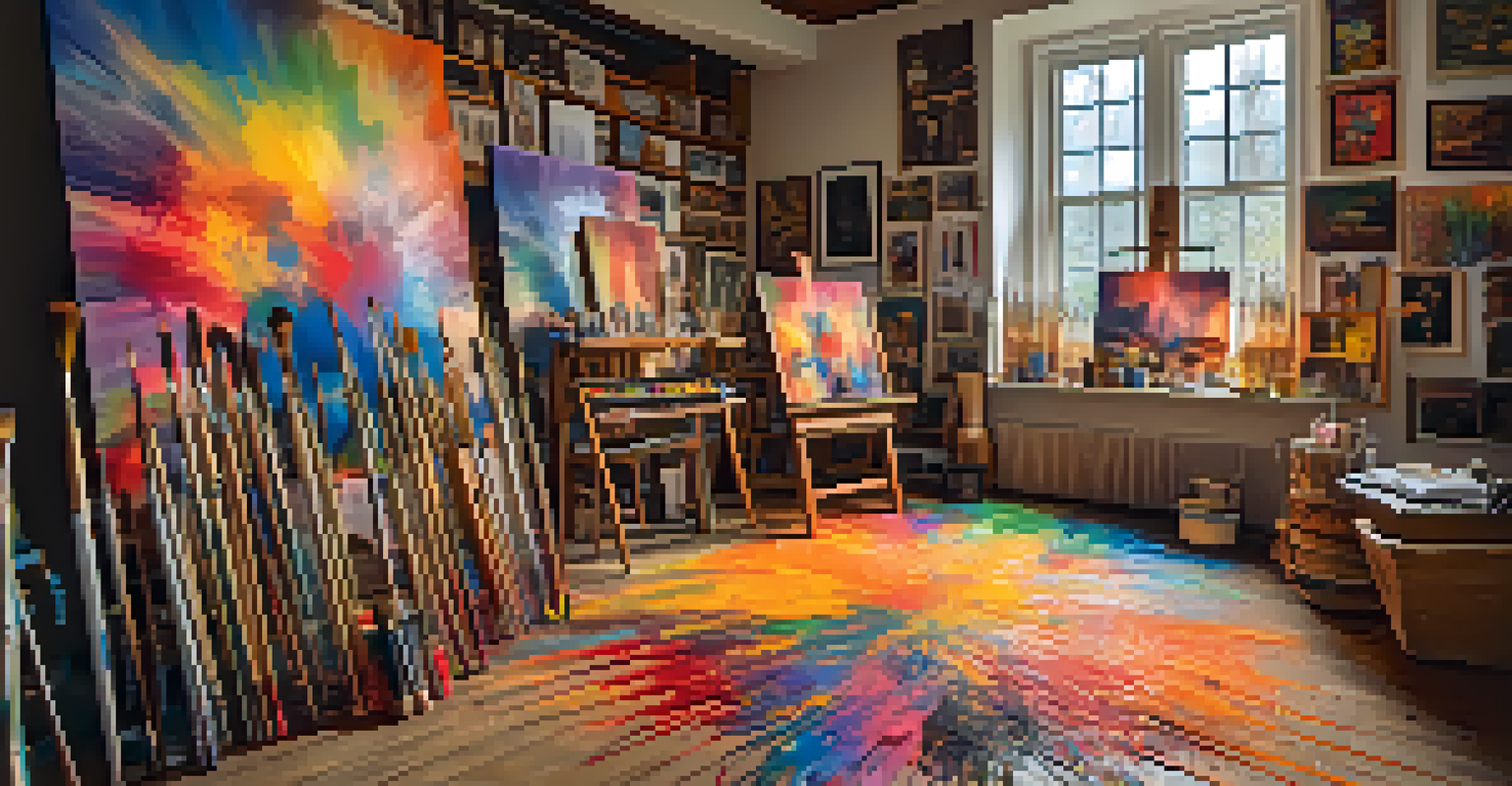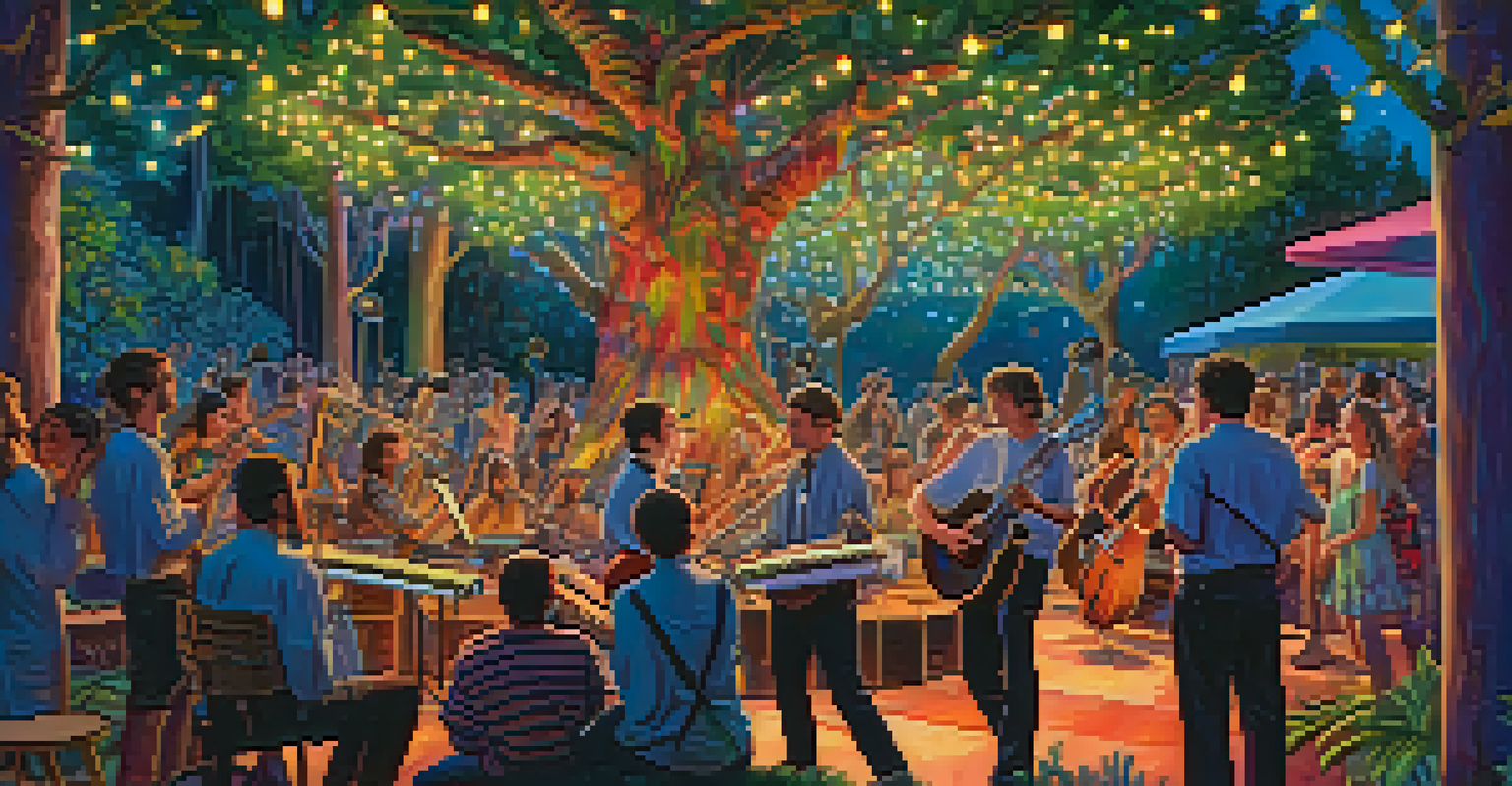Psychedelic Sounds: The Role of Entheogens in Music

Understanding Psychedelic Sounds and Their Origins
Psychedelic sounds are a fascinating blend of music that often evokes altered states of consciousness. Originating in the 1960s, this genre captured the essence of the counterculture movement, intertwining music with spiritual exploration. Artists like The Beatles and Pink Floyd experimented with innovative sounds, creating a sonic landscape that invited listeners to dive deeper into their own minds.
Music can change the world because it can change people.
These sounds frequently incorporate elements like reverb, echo, and unusual chord progressions, contributing to a dreamlike experience. Similar to how a painter uses colors to evoke emotions, musicians use these techniques to transport their audience to another realm. The result is a rich tapestry of auditory experiences that resonate with the listener's inner journey.
Today, the influence of psychedelic sounds continues to evolve, blending with various genres from electronic to indie rock. As more artists explore these sonic depths, they keep the spirit of experimentation alive. This ongoing evolution raises the question: how do these sounds relate to the use of entheogens?
What Are Entheogens and Their Cultural Significance?
Entheogens are substances, often derived from plants, that are used in spiritual or religious contexts to facilitate altered states of consciousness. The word 'entheogen' itself means 'generating the divine within,' which perfectly captures their intended purpose. Cultures around the world have employed these substances for centuries, from the indigenous use of peyote in Native American rituals to the Amazonian ayahuasca ceremonies.

These experiences are often said to foster a deep connection between the individual and the universe, enhancing creativity and introspection. Just as a compass guides a traveler, entheogens can guide individuals through their inner landscapes, revealing insights and emotions that may be hidden in everyday life. This powerful connection between sound and substance lays the groundwork for their combined impact in music.
Psychedelic Sounds and Culture
Psychedelic sounds emerged in the 1960s, intertwining music with spiritual exploration and reflecting the counterculture movement.
As more people become aware of entheogens' potential, there's a growing interest in how these substances influence artistic expression. Musicians, in particular, have turned to these substances to tap into their creativity and push the boundaries of their craft. This intersection between music and entheogens creates a unique cultural dialogue worth exploring.
The Connection Between Music and Altered States
Music has long been recognized for its ability to induce altered states of consciousness, often mirroring the effects of entheogens. Listening to specific types of music can evoke emotions, memories, and even transcendental experiences. Just as certain rhythms can get your heart racing, others can calm your mind, leading to a state of deep relaxation or ecstatic joy.
Psychedelics can help us to reconnect with ourselves and our universe, reminding us that we are not separate from the cosmos.
When combined with entheogens, music can amplify these experiences, creating a powerful synergy. Imagine drifting on a wave of sound while the effects of a psychedelic substance open your mind to new dimensions. This heightened state of awareness allows listeners to perceive music in ways they may never have considered before, making it a profound tool for exploration.
This connection is not merely anecdotal; scientific studies suggest that music can significantly enhance the psychedelic experience. The right playlist can turn a simple trip into a deeply spiritual journey, revealing layers of meaning and emotion. As we delve deeper into this relationship, we uncover the potential for music to act as a catalyst for profound personal growth.
Historical Examples of Psychedelics in Music
Throughout history, many musicians have openly embraced the use of entheogens, creating iconic works that reflect their experiences. The 1960s is a prime example, with bands like The Grateful Dead and Jefferson Airplane infusing their music with psychedelic themes. Their songs often captured the essence of the counterculture movement, celebrating freedom, love, and exploration.
One of the most famous examples is The Beatles' 'Lucy in the Sky with Diamonds,' which many interpret as a reflection of John Lennon’s experiences with LSD. The vivid imagery and whimsical soundscapes invite listeners to embark on a journey, blurring the lines between reality and imagination. This melding of music and psychedelics led to an explosion of creativity, influencing countless artists who followed.
Entheogens Enhance Creativity
Entheogens serve as tools for artists, inspiring creativity and pushing the boundaries of music through collective experiences.
More recently, artists like Tame Impala and Shpongle continue this tradition, incorporating psychedelic sounds and themes into their work. Their music often serves as a modern soundtrack for those interested in exploring consciousness. As we look back on these historical examples, we can appreciate how entheogens have shaped not just music but entire cultural movements.
Modern-Day Usage of Entheogens in Music Creation
In today's music scene, the use of entheogens among artists is more visible than ever. With a growing acceptance of psychedelics in many societies, musicians are increasingly open about their experiences and how these substances influence their creative process. For some, entheogens serve as a source of inspiration, sparking new ideas and pushing the boundaries of sound.
Collaborative projects often reflect this blending of creativity and consciousness. Artists report that consuming entheogens in a group setting can lead to unique musical experiences, where the collective energy enhances the creative output. This communal aspect echoes the rituals of ancient cultures, where music and psychedelics intertwined to create a shared spiritual experience.
As the conversation around mental health and well-being evolves, many musicians view entheogens as tools for personal exploration. By integrating these substances into their creative practices, they hope to challenge societal norms and inspire others to consider their own journeys. This modern approach continues to redefine the relationship between music and entheogens.
The Impact of Psychedelic Music on Mental Health
The therapeutic potential of psychedelic music is an emerging field of interest for both researchers and practitioners. Many studies suggest that music can enhance the healing effects of entheogens, promoting emotional release and introspection. Just as a well-timed melody can uplift your mood, the right soundscapes can help individuals process trauma and improve mental well-being.
Listening to psychedelic music during therapeutic sessions can create an immersive environment that encourages deeper connection and reflection. Participants often report feeling more in tune with their emotions, leading to breakthroughs that may not be achievable through traditional methods. This synergy between music and psychedelics opens new doors for mental health treatment.
Therapeutic Benefits of Music
The combination of psychedelic music and entheogens has shown potential in enhancing mental health treatment and emotional well-being.
As research continues to explore the benefits of this combination, we may see a shift in the way we approach mental health care. By incorporating psychedelic music into therapeutic practices, practitioners can offer a more holistic approach to healing. This evolving relationship highlights the importance of sound in our emotional and psychological well-being.
Conclusion: The Future of Psychedelic Sounds and Entheogens
The relationship between psychedelic sounds and entheogens is a captivating exploration of creativity, culture, and consciousness. As society becomes more open to discussing and understanding these substances, we can expect continued innovation in music and other art forms. This evolving landscape invites artists to experiment, pushing boundaries that challenge traditional norms.
Looking ahead, we may witness further fusion between music, technology, and psychedelic experiences. Virtual reality, for instance, could offer immersive environments where music and entheogens intersect in unprecedented ways. Such advancements promise to redefine how we experience sound and consciousness, potentially enriching our cultural dialogues.

Ultimately, as we embrace the power of psychedelic sounds and entheogens, we open ourselves up to new dimensions of creativity and understanding. This journey invites us to explore not just the music but also the deeper connections we share with ourselves and the universe. Together, we can continue to uncover the transformative potential of sound and substance.